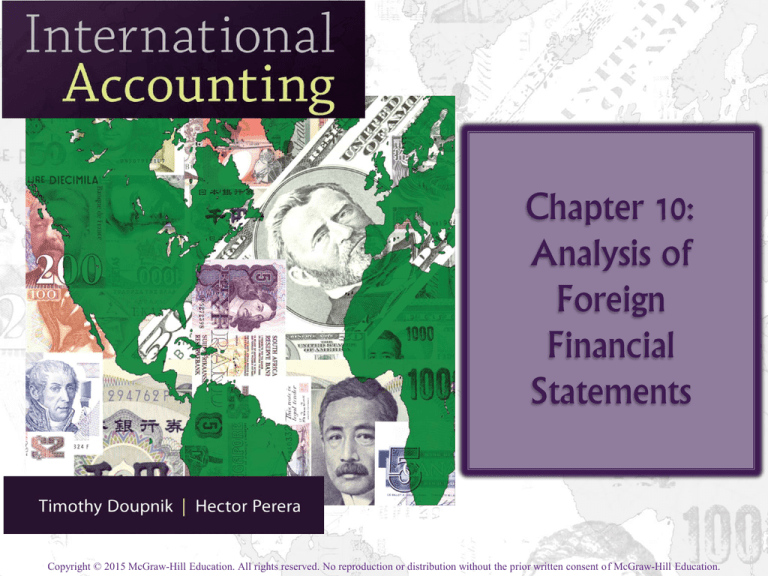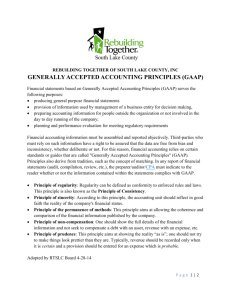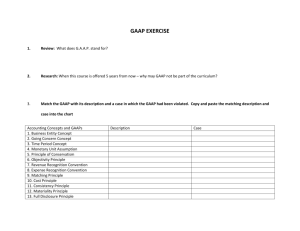
Chapter 10:
Analysis of
Foreign
Financial
Statements
Copyright © 2015 McGraw-Hill Education. All rights reserved. No reproduction or distribution without the prior written consent of McGraw-Hill Education.
Chapter Topics
Overview of financial statement analysis
Reasons for analyzing foreign financial statements
Potential problems in analyzing foreign financial
statements
Possible solutions to problems associated with
analyzing foreign financial statements
Restating foreign financial statements to U.S. GAAP
illustrated
10-2
Learning Objectives
1.
2.
3.
4.
Discuss reasons to analyze financial statements of
foreign companies
Describe potential problems in analyzing foreign
financial statements
Provide possible solutions to problems associated
with analyzing foreign financial statements
Demonstrate an approach for restating foreign
financial statements to U.S. generally accepted
accounting principles (GAAP)
10-3
Overview of Financial Statement Analysis
Accounting analysis
Reflection of economic reality
Sources of distortion in financial statements:(e.g. inconsistent
standards, estimation errors and intentional manipulation)
Financial analysis
Cash flow, profitability and risk analysis
Prospective analysis
Combining results of accounting analysis and financial
analysis, along with business environment analysis and
company strategy, to forecast future cash flow and
income
10-4
Reasons to Analyze Foreign Financial
Statements
Foreign portfolio investment
Investors can diversify some risk by investing
internationally
While stock returns in many countries are positively
correlated with U.S. returns, these correlations are far
from perfect
International investors, including managers of
international mutual funds, rely on foreign financial
statements
10-5
Reasons to Analyze Foreign Financial
Statements
International Mergers and Acquisitions
The frequency and size of international corporate
mergers has increased in recent years
Examples include Ambev/Anheuser-Busch; BP/Amoco; and
acquisitions by Ford Motor such as Volvo (of Sweden), who,
in 2010, reached a deal to sell Volvo to China’s Zhejiang
Geely Holding Group
The purchaser of an international company needs to
analyze the target company’s financial statements for
determining how much to pay
10-6
Reasons to Analyze Foreign Financial
Statements
Other reasons
Making credit decisions about foreign customer
Evaluating the financial health of foreign suppliers
Benchmarking against global competitors
10-7
Potential Problems in Analyzing Foreign
Financial Statements
Data accessibility
Relative to the U.S., financial information is difficult to
obtain in many countries
While databases of foreign financial statements do
exist, these can contain errors and present in a variety
of formats
These databases also do not contain complete disclosure
notes
Another approach is to obtain a copy of the foreign
company’s annual report
Annual Reports.com provides reports for companies
listed on U.S., U.K., Canada and Australia stock
exchanges by name, ticker symbol, stock exchange and
industry
10-8
Potential Problems in Analyzing Foreign
Financial Statements
Language
Many international companies do not produce financial
statements in English
The financial statement user could hire a translator or
develop multilingual capability
Since English is the language of business, companies in
many foreign countries produce “convenience
translations” of their financial statements in English
10-9
Potential Problems in Analyzing Foreign
Financial Statements
Currency
Many international companies produce their financial
statements in a currency other than the U.S. dollar
These can be converted to U.S. dollars by translating all
balances at the exchange rate at the end of the current
year
In order to avoid distortions, the current exchange rate
should be used for all previous years
Analysis using ratios is not distorted by different
currencies
10-10
Potential Problems in Analyzing Foreign
Financial Statements
Terminology
Differences in terminology exist between countries using the
same language
For example, “inventory” in the U.S. used to be called “stocks” in the
U.K
In cases of convenience translations, sometimes these include
terminology unfamiliar to English speakers
Knowledge of the business and accounting environment, as
well as a careful reading of the notes to the financial
statements can help alleviate problems in understanding odd
terminology
Much of the U.S. and U.K. differences were removed in 2005
when the U.K. adopted IFRS
10-11
Potential Problems in Analyzing Foreign
Financial Statements
Format
Most differences are not problematic because the
information is given, just in a different place
However, other format differences are a problem
because the information is not provided
It is common in Europe to not report the amount of cost of
goods sold
This prevents an analyst from determining gross profit
margin
10-12
Potential Problems in Analyzing Foreign
Financial Statements
Extent of disclosure
Disclosure internationally tends to be limited compared to
the U.S. where full disclosure is fundamental
Some of the most serious disclosure limitations are
information on segments, asset valuation, foreign
operations, interim statements, and reserves
Lack of disclosure contributes to the significance of format
problems
Globalization of capital markets tends to enhance
disclosure as companies attempt to attract investors
10-13
Potential Problems in Analyzing Foreign
Financial Statements
Timeliness
Aspect of the relevance of information
Varies significantly internationally since filing deadlines
differ from country to country
Requirements about the frequency of information also
vary internationally from quarterly to annual reporting
There is very little investors can do to overcome these
problems
10-14
Potential Problems in Analyzing Foreign
Financial Statements
Differences in accounting principles
Often result in significantly different income and other
financial statement amounts
Some of the most troublesome areas are consolidations,
fixed asset valuation, depreciation, and goodwill
Cause some investors to limit the scope of their
investments
Some investors attempt to reframe foreign financial
statements to a more familiar GAAP
Another approach is to use a stripped down measure of
earnings that excludes items most affected by diversity
10-15
Potential Problems in Analyzing Foreign
Financial Statements
International Ratio Analysis
Differences in culture and economic environments have
an impact on the relevance of ratios
A study of companies in Japan, Korea, and the U.S.
found significant differences due to business environment
Japanese and Korean companies borrow much more on
a short-term basis than U.S. companies, leading to lower
current ratios
Debt ratios also tend to be higher in Japan and Korea
because of the sources of financing
Lower profit margins in Japan in 1978, relative to the
U.S., can be partly explained by the Japanese
companies having their focus on market share as
opposed to profits
10-16
Restating Financial Statements
Form 20-F
Foreign companies that file non-U.S. GAAP financial
statements with the SEC are required to complete a
Form 20-F, with the exception of those that use IFRS
Reconciles net income and stockholders’ equity to U.S.
GAAP
However, there is no requirement to reconcile assets and
liabilities
In essence, this represents a partial restatement from
foreign GAAP to U.S. GAAP
10-17
Restating Financial Statements
Form 20-F
Some ratios, such as return on equity, can be computed
as if under U.S. GAAP
Most other ratios cannot be computed as if under U.S.
GAAP
Analysts can overcome this by performing the restatement
of financial statement items
10-18
Restating Financial Statements
Restatement overview – Step one of two
Reformatting
Involves transforming the financial statements into a U.S.
format
One part is transforming terminology differences
Presentation differences are also transformed
Item definitions and classifications are transformed
Restatement overview – Step two of two
Involves restating the foreign GAAP amounts to U.S.
GAAP amounts
Easier when the company files a Form 20-F
Sometimes, companies will present a similar reconciliation
without actually filing the Form 20-F
10-19
Restating Financial Statements
Restatement overview – Step two of two
Notes to the financial statements are very useful in
completing this step
Step one mechanics – Reformatting
Begin with a four column worksheet in U.S. GAAP format
Columns are Local GAAP, debits, credits, and U.S. GAAP
Amounts are presented in the original currency
Prepare worksheets for income statement, statement of
retained earnings, and balance sheet
Line items in the worksheet are presented in the
terminology of U.S. account titles
10-20
Restating Financial Statements
Step two mechanics – Restating
Affects the debit and credit columns in the worksheet
The nature of these entries is essentially adjusting and
reclassification
Some entries affect current net income or beginning
retained earnings, while others affect both
Each entry reflects the adjustment needed to reconcile to
U.S. GAAP from local GAAP
10-21
Restating Financial Statements
Partial example -- restated financial statements
Assume that the local GAAP column of the financial
statements being restated has already been
reformatted into the U.S. GAAP titles and amounts
These amounts include:
Sales
Cost of sales
SG&A expense
Other income
Retained earnings (beg)
2,000
1,100
200
100
500
Cash
500
Inventory
600
Deferred liability
50
Pension liability
800
Retained earnings (end) 1,300
10-22
Restating Foreign Financial Statements to U.S.
GAAP
Partial example -- restated financial statements
Under U.S. GAAP the current pension liability costs are
40 units higher and the beginning balance in pension
liability is 100 units higher
These costs are accounted for as SG&A expense
Cash realized of 20 units during the current year is
considered a deferred liability under U.S. GAAP and is
other income under local GAAP
10-23
Restating Foreign Financial Statements to U.S.
GAAP
Partial example -- Income statement
U.S. Format
Sales
Cost of sales
Gross profit
S,G,&A expense
240
Other income
20
80
Net Income
Local
GAAP
Dr.
2,000
1,100
900
200
U.S.
Cr.
GAAP
2,000
1,100
900
40
100
800
740
10-24
Restating Foreign Financial Statements to U.S.
GAAP
Partial example – Retained earnings statement
Local
U.S. Format
GAAP
R/E, beginning
400
Net income
740
R/E, ending
1,140
GAAP
500
U.S.
Dr. Cr.
100
800
1,300
10-25
Restating Foreign Financial Statements to U.S.
GAAP
Partial example – Balance sheet
U.S. Format
Cash
500
Inventory
…
…
Deferred liability
70
Pension liability
Local
GAAP
600
500
50
800
…
...
Retained Earnings
600
…
Dr.
U.S.
Cr.
GAAP
…
1,300
20
100
40
940
1,140
10-26
End of Chapter 10
10-27






